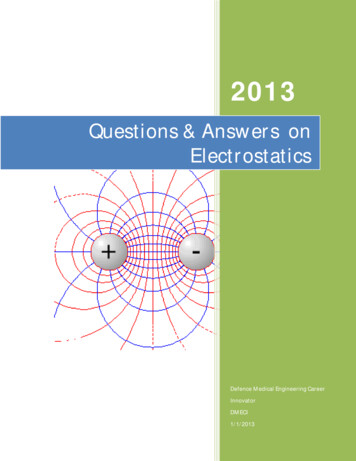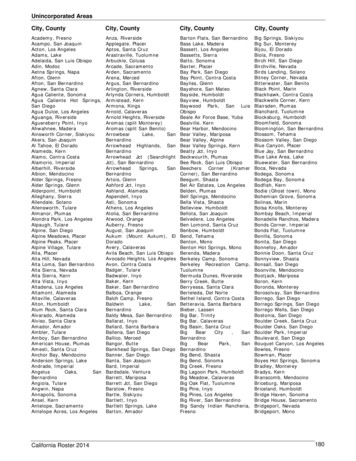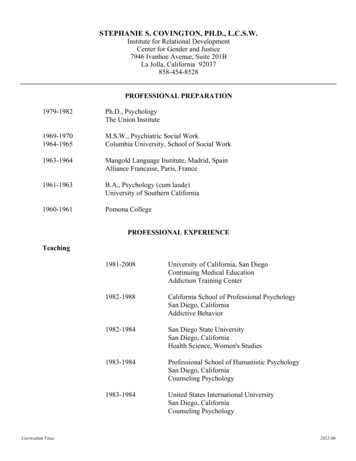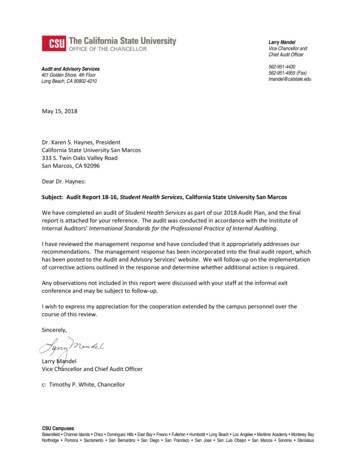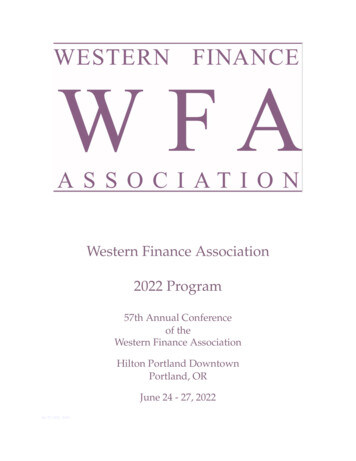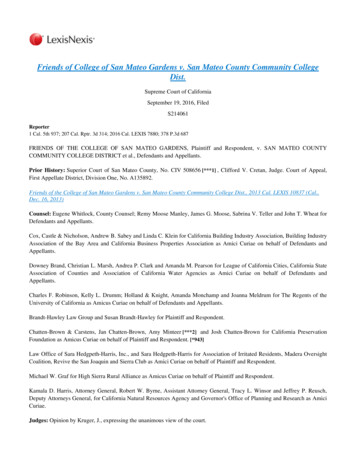
Transcription
Physics 1Ba – Professor Kleinfeld – Final Exam (24 March 2007) – 30 Multiple choice questionsElectrostatics qqThe force on charge q1from charge q2 is F12 k e 12 2 r̂12 , where the direction vector r̂12 points from q2 tor129q1 and the proportionality constant is ke 8.99x10 Nm2/C2.Note that the permittivity of free space is ε0 1/(4πke) 8.85x10-12 C2/(Nm2) 8.85x10-12 A2s4/(kg m3).Note that the unit of elemental electronic change is e- -1.60x10-19C. The force on a test charge q0 induced by an electric field, denoted E , is F q 0 E .Fields and PotentialsThe electric flux through a surface is Φe E ΔA , where Ε Ε cosθ is the component of theAll Surfacesfield that parallels the norm to the surface; θ is the angle between the direction of the field and the norm.sGauss’ Law relates the total flux through a closed surface to the net charge enclosed by the surface, i.e.,Φe 4 π ke QTotal. q The electric field produced by a point charge q at the origin, i.e., r 0, is E k e 2 r̂ where r̂ is therradius vector in spherical coordinates. λThe electric field produced by a line charge, with charge per unit length λ, is E 2k er̂ , where therline is defined to lie along the ẑ axis and r̂ is the radius vector in cylindrical coordinates. The electric field produced by a surface charge, with charge per unit area σ, is E 2π k eσ n̂ , where thesurface lies in the x̂-ŷ plane and ẑ corresponds to the normal to the x̂-ŷ plane in Cartesian coordinates.Work-Energy Theorem: W ΔKE ΔPEElectric potential: ΔV -E Δx cos θ, where ΔV V keΔPEQqa distance r away from a point charge q.rCurrent, Resistance and CapacitanceΔQCurrent:I or I n e vD A where n is the density of charge carriers, vD is the drift velocityΔtand A is the cross-section of the wire.Capacitance: Q C ΔV where C I CΔVΔtEnergy Stored κ Afor parallel plates and κ is the dielectric constant4π k e d111 22Q ΔV C ( ΔV ) Q222C
Physics 1Ba – Professor Kleinfeld – Final Exam (24 March 2007) – 30 Multiple choice questionsResistance:V I R where R ρKirchoff’s Laws:L; ρ is the resistivity in Ohm-m and L is the length of the wire.A1) Sum of voltage drops around any loop is zero, i.e., gains losses2) Sum of current flow at a node is zero, i.e., total current in total current outPower Dissipated IV I2R V2/RA resistor/capacitor pair charges with a characteristic time, given by the product of R and C, i.e., τ RC.Magnetostatics (Electrostaticsin the Fast Lane) Force on a test charge q0 induced by electric field E and magnetic field B , is F q 0 E q 0 v B . The cross product and has magnitude v B sinθ and a direction that is found from the “right hand rule”.Force per unit length on a straightthat carries a current I (where I has direction given by the motion wire of positive charge carriers) is F/l I B . The cross product is defined as above.The force per unit length between two straight wires that carry current I1 and I2 respectively, and areIIseparated by a distance d, is F/L µ0 1 2 , where µ0 1.3x10-6 T m / A.2π dFor completeness, µ0ε0 1/c2, where c is the speed of light.The torque between a loop of cross-sectional area A that carries a current I and a uniform magnetic fields is τ µ B , where µ IA is known as the magnetic moment.When the loop contains multiple turns of wire, µ NIA where N is the number of turns.Ampere’s Law relates the magnetic field in a loop to the current, i.e., I For a straight wire, B µ0()1µ0 B ΔLAll SegmentsIθ̂ , where the direction is given by the right-hand rule and R is2πRthe distance from the wire. NFor a solenoid, B µ0 I ( ẑ ) .LFaraday’s Law relates the change in magnetic flux, φMagnetic B ΔA , to the potential V, or theAll Surfacescurrent, V/R, induced in a loop, i.e., V - NΔφMagneticwhere N is the number of turns in the loop andΔtthe minus sign implies that the induced field - caused by the induced current - opposes the original field.Generator:V NBA ω sin ωt where ω is the rotational frequency in radians/s (recall ω 2 π f).2 N Inductance: NΔφ L ΔI where L µo Al for a solenoid with N/l turns/length, cross-sectional l area A, and length l.ΔIV LΔt
Physics 1Ba – Professor Kleinfeld – Final Exam (24 March 2007) – 30 Multiple choice questionsEnergy Stored 11I Nϕ Magnetic L I 222A resistor/inductor pair has a characteristic time for a voltage change, given by the quotient of L and R,i.e., τ L/R.AC Circuit AnalysisA resistor has an impedance of R and a voltage that faithfully tracks the current, i.e., if IR(t) I0 sin(2πft), then VC(t) I0R sin(2πft).A capacitor has an impedance of ZC 1/(2πfC) and a voltage that lags the current by 90o, i.e., if IC(t) I0 sin(2πft), then VC(t) I0/(2πfC) sin(2πft-π/2).An inductor has an impedance of ZL 2πfL and a voltage that leads the current by 90o, i.e., if IL(t) I0 sin(2πft), then VL(t) 2πfL I0 sin(2πft π/2).The current flow and voltage drops in a loop containing an inductor and capacitor has a resonance whenthe driving frequency satisfies1 1fresonance 2π LCElectromagnetic RadiationDispersion relation in the vacuum is:fλ c,where f is the frequency of the radiation, λ is the wavelength, and c is the speed of light, withc 2.99 x 108 m/s.The ratio of the electric to magnetic field in an electromagnetic wave equals the speed of light, i.e.:E(t) cB(t)Electromagnetic waves carry energy as they travel; the average power per unit area is the intensity,denoted I, with:11c 22I Emax Bmax EmaxBmax2 µ02 µ0 c2 µ0SeriesCapacitors1C eq Parallel1C1 1C2 1C3InductorsLeq L1 L2 L3 ···ResistorsReq R1 R2 R3 ··· ···Ceq C1 C2 C3 ···1L eq1R eq 1L11R1where Emax and Bmax are the maximum values of the electric and magnetic fields. 1L21R2 1L31R3 ··· ···
Physics 1Ba – Professor Kleinfeld – Final Exam (24 March 2007) – 30 Multiple choice questionsFinally – the Final!1. The circuit in figure 1 is a minimal model for the intracellular potential, VCardiac, of acardiac cell during the plateau phase of the cardiac action potential. What is theexpression for VCardiac in terms of RLeak, RCa, VLeak, and VCa? Mind the signs!A. (RLeakVCa - RCaVLeak)/(RLeak RCa)B. (RCaVCa - RLeakVLeak)/(RLeak RCa)C. VCa - VLeakD. (RLeakVCa RCaVLeak)/(RLeak RCa)E. (RCaVCa RLeakVLeak)/(RLeak RCa)2. A circuit consists of a series combination of two capacitors, with values C1 and C2, and aresistor, with value R, as shown in figure 2. If the switch is closed at time t 0, what isthe value of the current immediately after the switch is thrown?A.B.C.D.E.(V/R)[(C1C2)/(C1 C2)2]V/R0(V/R) [1 – (C1C2)/(C1 C2)2]Insufficient information to answer3. For the above circuit (Figure 3) with the switch is closed at time t 0, what is thevalue of the current a very long time after the switch is thrown?A. V/R[(C1C2)/(C1 C2)2]B. V/RC. 0D. (V/R) [1 – (C1C2)/(C1 C2)2]E. Insufficient information to answer
Physics 1Ba – Professor Kleinfeld – Final Exam (24 March 2007) – 30 Multiple choice questions4. Two positive charges of strength Q1 1.0x10-3 Coulombs sit along the x-axis as shownin figure 3, with L 10 cm. What is the force on a negatively charged particle ofstrength Q2 -1.0x10-6 Coulombs that sits at (x, y) (L, L)? Recall that x̂ points to theright along x and ŷ points up along y.A) –3.2x102 x̂ –1.2x103 ŷB) –3.2x102 x̂ –9.2x102 ŷC) –4.5x102 x̂ 1.3x103 ŷD) –4.5x102 x̂ 0 ŷE) –4.5x102 x̂ –1.3x103 ŷ5. A parallel plate capacitor is formed from two square plates with area A 5000 cm2,spaced d 1.0 mm apart, as in figure 4. The gap between the plates is filled with air(dielectric constant κ 1). What is the capacitance?A.B.C.D.E.2.2x10-9 F4.4x10-9 F2.2x10-7 F4.4x10-7 F8.8x10-7 F6. A negative charged particle is placed in a uniform electric field that points to the left.It is initially at rest. Neglect gravity. What happens?A.B.C.D.E.The particle accelerates to the right gaining both kinetic and potential energyThe particle accelerates to the right gaining kinetic but losing potential energyNothing – a particle at rest remains at restThe particle accelerates to the left gaining kinetic but losing potential energyThe particle accelerates to the left gaining both kinetic and potential energy
Physics 1Ba – Professor Kleinfeld – Final Exam (24 March 2007) – 30 Multiple choice questions7. A battery supplies current to a circuit with 4 resistors, as shown in figure 6. What isthe correct expression for the potential V1?A.B.C.D.E.1/4 VB1/3 VB1/2 VB2/3 VB3/4 VB8. What is the correct expression for the potential V2 in figure 6?A. 1/8 VBB. 1/4 VBC. 1/3 VBD. 1/2 VBE. 3/4 VB9. A positron, with elemental charge e and velocity v, enters a region with both auniform magnetic field, B 0.5 T ( ), and a uniform electric field, E -1.0x104 V/m ( ŷ ),i.e., the particle enters from the left, the magnetic field points into the paper and theelectric field points downward, as shown below in figure 7. Is there an initial nonzerovelocity for which the electron is not deflected and, if so, what is that velocity?A.B.C.D.Yes: 0.5x104 m/s ( x̂ )Yes: 1.0x104 m/s ( x̂ )Yes: 2.0x104 m/s ( x̂ )No: the electron always is deflected downward ( -ŷ direction).E. No: the electron always is deflected upward ( ŷ direction).
Physics 1Ba – Professor Kleinfeld – Final Exam (24 March 2007) – 30 Multiple choice questions10. Two parallel wires are separated by a distance d 1.0 µm and carry equal but oppositecurrents of I 1.0 mA each, as shown in figure 8. What is the value of the magnetic field– magnitude and sign – at point A?A. 2.7x10-4 T ( -ŷ ); downwardB.C.D.E.2.7x10-4 T ( ); into page5.3x10-4 T ( ); into page2.7x10-4 T ( ); out of page5.3x10-4 T ( ); out of page11. With reference to the same arrangement of current flow (figure 8 and parameters asin question 10), what is the value of the magnetic field – magnitude and sign – at point B?A.B.C.D.E.0T4.0x10-4 T ( ); into page4.0x10-4 T ( ); out of page8.0x10-4 T ( ); into page8.0x10-4 T ( ); out of page12. Two inductors, each with value L 12 mH, are connected in series with a capacitor,with value C 470 nF, and driven by a variable frequency sinusoidal voltage, as shown infigure 9. For what value of frequency, f, is the current flow in the circuit at resonance?A.B.C.D.E.1.5 Hz1.5 kHz3.0 kHz3.0 MHzThe value depends on V0 as well as on L and C.
Physics 1Ba – Professor Kleinfeld – Final Exam (24 March 2007) – 30 Multiple choice questions13. A sinusoidal voltage source, V0 sin(2πft) drives a circuit that consists of a resistor andcapacitor in series, as shown in figure 10. A current I(t) flows through the circuitelements. Which statement is true under steady-state conditions?A. The current through the capacitor and the resistor are in phase with each other.B. The current through the capacitor and the resistor vary 900 out of phase withrespect to each other.C. The voltage drop across the capacitor, VC(t), and the resistor, VR(t), are in phase witheach other.D. The voltage drops VC(t) and VR(t) are 1800 out of phase with respect to each other.E. No current can flow through the capacitor under steady-state conditions.14. A square loop of wire moves at constant speed across a uniform magnetic field that isconfined to a square region of space, as shown in figure 11. The sides of the loop are onehalf the length of the sides of the region with the field. Which of the following bestdescribes the behavior of the induced current?A. The current flow is zero (panel A), then clockwise (CW) (panel B), then zero (panel C).B. The current flow is zero (panel A), then counterclockwise (CCW) (panel B), then zero(panel C).C. The current flow is CW (panel A), then zero (panel B), then CCW (panel C).D. The current flow is CCW (panel A), then zero (panel B), then CW (panel C).E. The current flow is CW (panel A), then zero (panel B), then CW (panel C).15. Each wire of a high-voltage transmission line (700,000 V with respect to ground)carries 1,000 A for a distance of 100 km. If the resistance of the wire is 0.5 Ω/km, whatis the voltage drop caused by resistive losses?A. 50 VB. 500 VC. 50,000 VD. 650,000 VE. 750,000 V
Physics 1Ba – Professor Kleinfeld – Final Exam (24 March 2007) – 30 Multiple choice questions16. For the circuit in figure 12, each of the resistors has a value of R 2.0 Ω, while thelight bulb has a resistance of Rbulb 1.0 Ω. The battery has a potential difference ofVB 14 V. Which of the following statements best corresponds to the potential dropacross the bulb?A. 4.7 VB. 7.0 VC. 9.4 VD. 12.0 VE. 14.0 V17. Consider an electron that moves within a plane that lies normal to a uniform magneticfield, as denoted in figure 13. Neglect the force of gravity. Which of the followingchoices best describes the trajectory of the electron?A. The electron will move in a straight line.B. The electron will slow down and come to a stop.C. The electron will move in a clockwise (CW) circle.D. The electron will move in a counterclockwise (CCW) circle.E. Without knowing the precise speed and value of the magnetic field, the motion cannotbe specified.18. An AC circuit with a frequency of f 100 Hz includes an inductor. The inductiveimpedance (reactance) is ZL 50 Ω. What is the value of the inductance (L)?A.B.C.D.E.20 mH80 mH.240 mH.500 mH.740 mH.
Physics 1Ba – Professor Kleinfeld – Final Exam (24 March 2007) – 30 Multiple choice questions19. A resistive network consists of a battery and 4 resistors arranged as a parallelcombination of 3 resistors in series with the fourth resistor, as shown in figure 14. Whatis the current that flows through the 10 Ω resistor?A.B.C.D.E.0.18 A0.25 A0.59 A1.0 A1.2 A20. The inductance of an inductor depends upon:A. The amount of current, I, that flows through the inductor.B. The time rate of change of current, dI/dt, in the inductance.C. The geometry of the inductor.D. The frequency, f, of the alternating current or voltage source that drives the circuit.E. The overall impedance, Z, of the circuit that contains the inductor.21. The capacitance of a capacitor depends upon:A. The drop in voltage, V, across the inductor.B. The time rate of change of voltage, dV/dt, across the capacitance.C. The geometry of the capacitor.D. The frequency, f, of the alternating current or voltage source that drives the circuit.E. The overall impedance, Z, of the circuit that contains the capacitor.
Physics 1Ba – Professor Kleinfeld – Final Exam (24 March 2007) – 30 Multiple choice questions22. An airplane with a wingspan of 60.0 m flies parallel to the Earths surface at a pointwhere the vertical (downward) component of the Earth’s magnetic field is 0.4x10-4 T. Ifthe induced potential between the tips of the wings is 0.90 V, what is the speed of theplane relative to the ground?A.B.C.D.E.250 m/s338 m/s375 m/s417 m/s750 m/s23. A 100 m long conducting wire used for animal tracking has a radius of 25 µm and aresistance of 150 Ω. What is the resistivity of the metal used to make the wire?A.B.C.D.E.2.9x10-9 Ω/m7.6x1012 Ω/m2.9x10-9 Ω m2.9x103 Ω m7.6x1012 Ω m24. An MRI machine for rodents has a solenoid coil that produces a field of 5.0 T with a10 cm diameter bore (5.0 cm solenoid radius) and a 50 cm length. If the maximumcurrent that NbTn superconducting wire can tolerate in 800 A, how may turns of wire arenecessary to achieve the required field.A.B.C.D.E.25250050005.0x1042.5x105
Physics 1Ba – Professor Kleinfeld – Final Exam (24 March 2007) – 30 Multiple choice questions25. What is the electric field at the origin, where qo is located, for the configuration ofpositive and negative elemental changes ( e 1.6x10-19 Coulombs) along a line shown infigure 15?A.B.C.D.E.1.2x107 N/C; to the right ( x̂ )2.5x107 N/C; to the right ( x̂ )01.2x107 N/C; to the left ( x̂ )2.5x107 N/C; to the left ( x̂ )26. A dish antenna with a radius of 30.0 m receives, at normal incidence to the dish, aradio signal from a distant star, as shown in figure 16. The radio signal is a continuoussinusoidal wave whose electric field has an amplitude of E0 0.10 V/m. Assume that theantenna absorbs all the radiation that falls on the dish. What is the intensity, I, of theradiation received by the antenna?A.B.C.D.E.-521.3x10 W/m4.0x103 W/m21.3x106 W/m21.3x10-5 V/m4.0x103 V/mFigure 1627. The switch in the LR circuit shown in figure 17 to closed at time t 0. How muchtime is required for the current to reach 86.5 % of its final value? Hint: 1-exp{-2} 0.865.A.B.C.D.E.1.5x10-6 s3.0x10-6 s1.6x10-5 s3.2x10-5 s3.0 s
Physics 1Ba – Professor Kleinfeld – Final Exam (24 March 2007) – 30 Multiple choice questions28. The switch in the RC circuit shown in figure 18 to closed at time t 0. What is thetime constant, τ, for the decay of the current that flows in the circuit?.A.B.C.D.E.0.45 ns46 ms220 ms2.2 s11 s29. A square coil, comprised of N 100 turns of wire and L 10 cm on edge, rotates abouta vertical axis at 1500 revolutions/min, as in figure 19, at a point where the horizontal(tangential) component of the Earth’s magnetic field is 0.2x10-4 T. Calculate themaximum voltage drop (EMF) induced in the coils as it rotes in the Earth’s field. Mind theunits!A.B.C.D.E.0.5 mV3.14 mV30 mV190 mV1.3 V30. A small charged ball of mass M 0.5 g is suspended by a string of length L 20 cm ina uniform electric field of E 1000 N/C x̂ (Figure 20). The string makes an angle ofθ 15o relative to the vertical axis. What is the net charge, Q, on the ball? Take g 9.8 m/s2. Mind the units!A.B.C.D.E.–1.3x10-6 C–1.8x10-6 C 1.3x10-6 C 1.8x10-6 C 5.0x10-6 C
2 ˆis F 12 k e q 1 q 2 r 12 2 r, where the direction vector ˆr 12 points from q 2 to q 1 and the proportionality constant is k e 8.99x10 9 Nm2/C2. Note that the permittivity of free space is ε 0 1/(4πk e) 8.85x10-12 C2/(Nm2) 8.85x10-12 A2s4/(kg m3). Note that the unit of elemental electronic change is e- -1.60x10-19C. The force .
